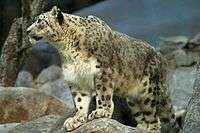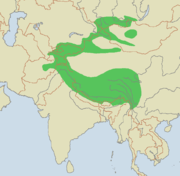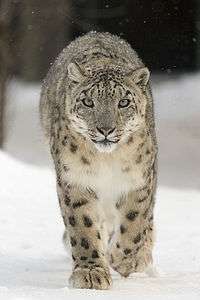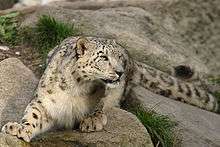Wikijunior:Big Cats/Snow leopard
< Wikijunior:Big Cats
Snow leopards dare to live where icy gales would freeze a human's blood in minutes. Their bodies are adapted to survive and thrive in an icy wilderness of breathtaking beauty and great danger. Until recently, no one had photographed a snow leopard in the wild.The first ever close-up pictures taken by humans were made by program Planet Earth, although very few people have had the privilege of seeing a snow leopard in its native habitat, much less taking its picture. The snow leopards seem to like it that way -- they avoid humans with amazing skill. Their fur contains swirls of gray and black, much like the colors of the rocky outcrops where they live. This coloration provides such good camouflage that a snow leopard can seem to disappear just by staying still.
Where do snow leopards live?

Snow leopards live in the high mountains of China and Central Asia, particularly throughout the Himalayas. They typically have a hunting range or territory of 100 square miles (260 square km), because very few prey animals live in the harsh, mountain habitat that is home to the snow leopard.
What do snow leopards look like?

Snow leopards have grey-and-white fur with long tails and rosettes on the flanks and spots on the head and neck, like jaguars. This color resembles the rocks and snow of their environment and helps them stalk their prey. Their tails are unusually long, thickly furred, and striped. Their paws are covered in fur to keep them warm and to act like snowshoes. During blizzards, they wrap their tail around their face, using it like a muff, to keep warm. Their eyes are round in shape, ranging from pale green to grey in colour. Male snow leopards weigh between 90-115 pounds (40-52 kg), and females weigh between 75-90 pounds (34-40 kg). Snow leopards have grey-and-white fur with long tails and rosettes on the flanks and spots on the head and neck, like jaguars. This color resembles the rocks and snow of their environment and helps them stalk their prey. Their tails are unusually long, thickly furred, and striped. Their paws are covered in fur to keep them warm and to act like snowshoes. During blizzards, they wrap their tail around their face, using it like a muff, to keep warm. Their eyes are round in shape, ranging from pale green to grey in colour. Male snow leopards weigh between 90-115 pounds (40-52 kg), and females weigh between 75-90 Snow leopards have grey-and-white fur with long tails and rosettes on the flanks and spots on the head and neck, like jaguars. This color resembles the rocks and snow of their environment and helps them stalk their prey. Their tails are unusually long, thickly furred, and striped. Their paws are covered in fur to keep them warm and to act like snowshoes. During blizzards, they wrap their tail around their face, using it like a muff, to keep warm. Their eyes are round in shape, ranging from pale green to grey in colour. Male snow leopards weigh between 90-115 pounds (40-52 kg), and females weigh between 75-90 pounds (34-40 kg).pounds (34-40 kg).
What do snow leopards eat, and how do they catch their prey?

Snow leopards eat almost anything they can catch, often hunting animals three times their size. Their main sources of food include wild sheep and goats, pikas, hares, and game birds. In the summer, they eat mostly smaller prey, such as marmots. At other times their prey includes wild boars, gazelles, markhor, bobak, tahr, ibex, bharal, mice, and deer. They stalk their prey and usually begin their attack when they are 20 to 50 feet (6-15 m) away.
The snow leopard's broad paws act as snow shoes and give them traction as they chase their prey across stone, snow, and icy surfaces. They are at their best when they can run across the hard, icy crusts that form above banks of deep snow while their hooved prey breaks through the crust, getting mired in the soft, underlying snow.
Fun facts
- The snow leopard has the longest tail of any cat.
- Snow leopards will attack prey weighing four times as much as themselves.
- The large, thickly furred paws of the snow leopard act as built-in snowshoes.
- Snow leopards have the thickest fur of all cats
- Unlike most other big cats such as the lion, snow leopards cannot roar.